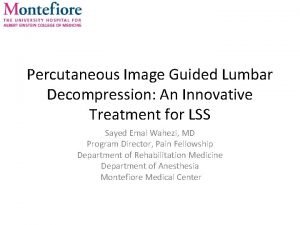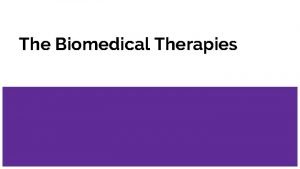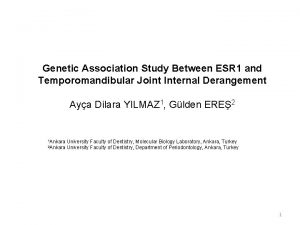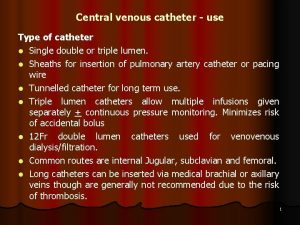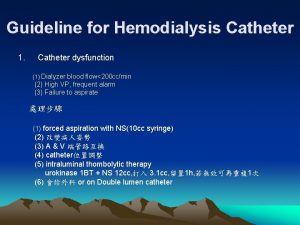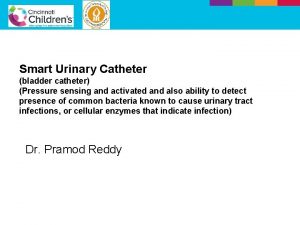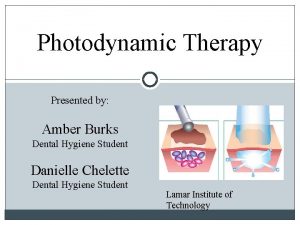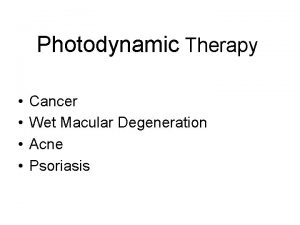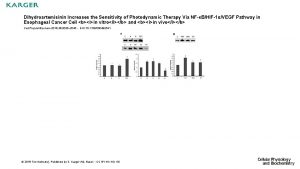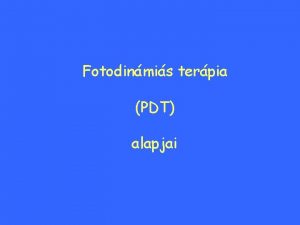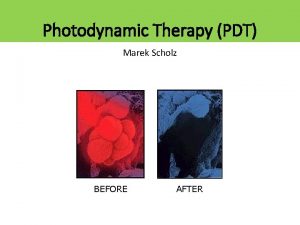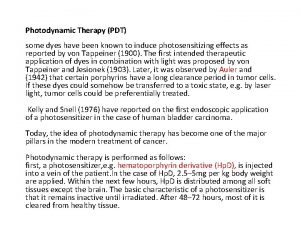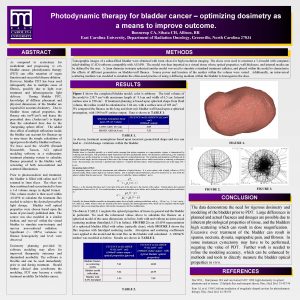CATHETER TECHNOLOGIES IMAGE GUIDED THERAPIES PHOTODYNAMIC THERAPY an

























- Slides: 25

CATHETER TECHNOLOGIES + IMAGE GUIDED THERAPIES PHOTODYNAMIC THERAPY: an attractive but complex multivariable process A. Illanes, Ph. D 14. 07. 2016 Alfredo Illanes

CATHETER TECHNOLOGIES + IMAGE GUIDED THERAPIES Outline Ø Introduction to PDT Ø The PDT process Ø Main Variables Ø Some applications in oncology Ø Limitations of PDT Ø Important dynamical information of the process Ø System identification vision 14. 07. 2016 Alfredo Illanes

CATHETER TECHNOLOGIES + IMAGE GUIDED THERAPIES Introduction: What is Photodynamic Therapy (PDT) Photochemical reaction involving: Main objective: 3 main components Photosensitizer (PS) Light O 2 Generation of ROS Ø highly cytotoxic reactive oxygen species 3 pathways of cell damage 14. 07. 2016 Alfredo Illanes

CATHETER TECHNOLOGIES + IMAGE GUIDED THERAPIES Introduction: main steps of the PDT process Transportation of PS inside the tumor exogeneously Waiting time Therapy Tissue O 2 endogeneously Photosesitizer Excited state light Injecting PS singlet O 2 ALA (better tumor selectivity) Photosesitizer Ground state Celullar toxicity (ROS) ALA application 14. 07. 2016 Alfredo Illanes Beginning of therapy time

CATHETER TECHNOLOGIES + IMAGE GUIDED THERAPIES Fakir-PDT Photosensitizer Topical SUMINISTRATION Systemic Interstitial Usually for thicker (>2 cm) and deeper tumors (>2 mm) systemic Dermaroller/Stamp Critical factors of PS for PDT effectiveness: Ø Distribution of PS in tissue Ø Delivery and transportation of PS Ideal characteristics of PS: Ø It should have a high absorption peak between 600 -800 nm Ø High photostability low photobleaching Ø high rate of ROS generation Ø Good pharmacokinetics properties Ø Large degree of selectivity Ø Accumulation in tumor compared to normal tissue 14. 07. 2016 Alfredo Illanes ALA Mixture

CATHETER TECHNOLOGIES + IMAGE GUIDED THERAPIES Light delivery critical factors Single Light delivery mode Fractionated – hyper Fractionated Metronomic Fluorescence excitation Action spectra Choice of access of light Light distribution Light wavelength As much homogeneous as possible 14. 07. 2016 Alfredo Illanes

CATHETER TECHNOLOGIES + IMAGE GUIDED THERAPIES Oxygen murine tumor example Perfusion Hypoxia Critical factors of O 2 for successful PDT outcome: Ø Tumor O 2 concentration Ø O 2 depletion produces by reaction Ø Requirement of a sufficiently large concentration of O 2 in the tumor tissue During irradiation O 2 depletion No ROS generation PDT IS CAPABLE OF INDUCING HYPOXIA WHICH CAN LIMIT THE EXTENT IN PDT DAMAGE Ø Due to rapid consumption of O 2 14. 07. 2016 Alfredo Illanes 30 minutes of PDT (Photofrin, 5 mg/kg, 75 m. W/ cm 2, 135 J/cm 2)

CATHETER TECHNOLOGIES + IMAGE GUIDED THERAPIES Applications of PDT: dermatology Aplication Otherapies Clinical use Actinic Keratosis Cryotherapy Good results with systemic and topical PS – comparable results with cryotherapy but better esthetic results - approved in USA, Canada and EU Bowen desease Surgery, cryotherapy, Better PDT results compared to cryotherapy and 5 radiotherapy and FU treatment topical 5 -FU Superficial Surgery, curettage, and nodular cryosurgery, surgical BCC laser, radiotherapy, topical 5 -FU 14. 07. 2016 Alfredo Illanes Almost complete response in superficial BCC. Excellent cosmetic outcomes compare to cryotherapy or surgery. Not clear better recurrence rate compared to surgery. Nodulr BCC response better for surgery

CATHETER TECHNOLOGIES + IMAGE GUIDED THERAPIES Applications of PDT: other oncological applications Application Clinical use Head and neck tumors • successfully employed to treat early carcinomas of the oral cavity, pharynx, and larynx. • Further research and trials for other kind of tumors affections • Barret esphagus best studied PDT application (ideal for PDT because mucosal areas are easily accesible for light) • Not enough trials and data for other locations • Attractive application: selective treatment of prostate while sparing surrounding normal tissue (not the case of surgery and radiotherapy which present morbidity due to proximity of normal structures) • Not enough trials mittigated results • Attractive target for PDT because of the geometry of bladder • Limited use, low research and trials – approved in Canada and some parts of EU • Current intensive clinical investigation • Brain tumor can have a high uptake of PS (selectivity) • Little data at the moment Digestive system tumors Prostate cancer Bladder cancer Brain tumors 14. 07. 2016 Alfredo Illanes

CATHETER TECHNOLOGIES + IMAGE GUIDED THERAPIES Some important remarks Dermatology Ø Skin cancers located mainly in the head and neck areas (80%) Ø Golden standard for treatment is surgical tumor excision Ø PDT has shown excellent cosmetic outcomes Ø Skin cancer is very attractive for PDT in terms of PS delivery (topically) Ø Easy access for PS Ø Less time interval between PS delivery and light administration Ø However … less light penetration Other tumors (esophagus, bladder, prostate) Ø PS delivery complicate only systemic Ø Light delivery good penetration Ø Not stratum corneum Ø Very good penetration in mucosal areas Ø Geometry can be a problem for light homogeneity 14. 07. 2016 Alfredo Illanes

CATHETER TECHNOLOGIES + IMAGE GUIDED THERAPIES Barriers of adoption into routine clinical practices Ø More than 250 randomized clinical trials have been officially reported Ø essentially all types of solid tumors with the exception of melanotic melanoma have been found to be positively responsive to PDT Ø However treatment relatively slow to enter mainstream in clinical practice Ø PDT can be considered a reasonable option for some applications Ø However, its effectiveness in the management of other types of tumors has not yet been unequivocally proven. Ø The major reasons: Ø only a few adequately powered randomized controlled trials have been performed to date Ø lack of optimal PDT parameters (illumination conditions, PS dose, monitoring) 14. 07. 2016 Alfredo Illanes

CATHETER TECHNOLOGIES + IMAGE GUIDED THERAPIES Main limitations of PDT Ø Ineffective against metastatic lesions highly localized nature of PDT Ø Complexity of the process and the interrelationship of the involved variables … not a complete understood process Ø Pain during some treatment protocols Ø PDT produces mostly superficial effects. Ø Still about 1 in 4 or 5 patients ultimately does not respond to the treatment and it is not understood why particular patients fail to respond Problem: the deeper the tumor (and the thicker the cornea) the less ALA and light arrives 14. 07. 2016 Alfredo Illanes

CATHETER TECHNOLOGIES + IMAGE GUIDED THERAPIES Many questions about the process What kind of patient (skin type, age), and tumorentity (AK, BCC, SCC, metastasis) needs what kind of photosensitizer (5 -ALA. esther) in which pharmaceutical formulation (galenics) and how much activated PPIX/mm 2 in what wave length (blue, greeen, red), light dosis and intensity to be curative treatable? 14. 07. 2016 Alfredo Illanes

CATHETER TECHNOLOGIES + IMAGE GUIDED THERAPIES Time constants and values involved in PDT process Ø Time between PS administration and light exposure • > 24 hours systemic (dark room wait time) • > 3 hours topical • Maybe less using nano-emulsion Ø Light exposure time: 5 minutes – 3 hours Ø depending on modality Ø Time interval between PDT sessions: hours, daily, weekly Ø Size of solid tumors that would be interesting to treat: 1 -10 cm (depth > 1 mm) ØLifetime of generated ROS 30 – 180 ns (10 – 320 ns in some works) Ø Photodynamic damage occurs very close to PS location (10 – 55 nm) 14. 07. 2016 Alfredo Illanes

CATHETER TECHNOLOGIES + IMAGE GUIDED THERAPIES Time constants and values involved in PDT process Ø Wavelength used for fluorescence and therapy Ø PPIX Fluorescence: Excitation 405 nm (380 -440 nm), emission spectrum 635 nm (also 700 -710 nm) Ø Therapy: 635 +- 5 nm Ø Photon intensity for producing ROS: Ø In principle the production of ROS requires an energy of 22. 5 kcal/mole Ø Light up to only 800 nm can generate ROS longer WL have insufficient energy for generating PDT reaction Ø Time and values of different light delivery modes: seconds-minutes hours 20 -150 m. W/c^m 2 20 -50 m. W/c^m 2 Hours - daily < 10 m. W/c^m 2 14. 07. 2016 Alfredo Illanes

CATHETER TECHNOLOGIES + IMAGE GUIDED THERAPIES Time constants and values involved in PDT process Ø PPIX spectral dynamical changes Given the time constant involved in the process Necessity of constant monitoring of variables for dosification Given Ø Localized effect of PDT reaction Ø Variation of PS in tumor Ø Size and depth of solid tumor Distributed measurements Therapy of the whole tumor 14. 07. 2016 Alfredo Illanes

CATHETER TECHNOLOGIES + IMAGE GUIDED THERAPIES Important variables and parameters in PDT Ø PS § PS availability (PPIX) Ø Light source § fluence rate (m. W/cm 2) § Total light fluence (J/cm 2) § Irradiation duration § Total light dosis Ø Oxygen § Tumor O 2 concentration Ø Tumor § Size § depth of tumor § Location § accessibility Dynamic and time-variant characteristics of many of these quantities Waiting time ALA Therapy Monitoring When to start? 14. 07. 2016 Alfredo Illanes Dosimetry? still PS?

CATHETER TECHNOLOGIES + IMAGE GUIDED THERAPIES Monitoring Ø Oxygen ü Changes of light absorption and scattering in tissue § diffuse reflectance spectroscopy (DRS) § diffuse optical tomography (DOT) § spatial frequency domain imaging (SFDI) Ø Blood flow ü Correlation between DRS’s measured at different time instants § diffuse correlation spectroscopy (DCS) Ø PS § Fluorescence spectra § Photobleaching of PPIX § ROS detection Ø Light source § Isotropic probe 14. 07. 2016 Alfredo Illanes

CATHETER TECHNOLOGIES + IMAGE GUIDED THERAPIES Challenges of Monitoring: system identification vision Very Complex process Ø Ø Ø How to identify the process through which observations Obtained In a reduced space Of difficult accesibility In real time For valuable quantitative information feedback 14. 07. 2016 Alfredo Illanes Time/space variant process Dosimetry

CATHETER TECHNOLOGIES + IMAGE GUIDED THERAPIES System identification vision Parametrical dynamical model Dosimetry model (reduced model to some important dynamics) Signal processing Featture extraction Observation of the process Monitoring Treatment strategy 14. 07. 2016 Alfredo Illanes PDT Process

CATHETER TECHNOLOGIES + IMAGE GUIDED THERAPIES Conclusions Ø PDT has not yet been introduced in clinical practice for tumor therapy Ø Main problem: complex and still hardly understood dynamical relationship between the involved variables Ø Process difficult to monitor and optimize Ø Dosimetry and drug-light interval are crucial issues of the process ü necessity of online monitoring Ø Process strongly time and space variant ü Need of signal processing and system identification approaches 14. 07. 2016 Alfredo Illanes

CATHETER TECHNOLOGIES + IMAGE GUIDED THERAPIES Thanks for your attention 14. 07. 2016 Alfredo Illanes

CATHETER TECHNOLOGIES + IMAGE GUIDED THERAPIES Annex 14. 07. 2016 Alfredo Illanes

CATHETER TECHNOLOGIES + IMAGE GUIDED THERAPIES System identification vision: a example Ø PDT could be an effective and minimally invasively applicable way to treat many different types of tumors Ø without radiation and large incisions by just applying a light pulse Ø it is unclear when the most appropriate timing for this light pulse after ALA injection is. Open question ü Drug-light interval can be predicted using system identification methods ü Observations: fluorescence of the recursors instead of the one of the PS 14. 07. 2016 Alfredo Illanes

CATHETER TECHNOLOGIES + IMAGE GUIDED THERAPIES System identification vision: an example Observations Dynamical model Identifiability? ? ? 14. 07. 2016 Alfredo Illanes PPIX prediction
 Therapies defined as “talk therapies” include
Therapies defined as “talk therapies” include Both psychoanalysis and humanistic therapy stress
Both psychoanalysis and humanistic therapy stress Bioness bits cost
Bioness bits cost Humanistic therapies aim to boost
Humanistic therapies aim to boost Percutaneous image-guided lumbar decompression (pild)
Percutaneous image-guided lumbar decompression (pild) Module 73: the biomedical therapies
Module 73: the biomedical therapies Biomedical therapy
Biomedical therapy Stiriti ayur therapies private limited
Stiriti ayur therapies private limited Westminster talking therapies
Westminster talking therapies Insight therapies
Insight therapies Advanced therapies apprenticeship community
Advanced therapies apprenticeship community Chapter 32 complementary and alternative therapies
Chapter 32 complementary and alternative therapies Trafford psychological therapies
Trafford psychological therapies Acceleration behavioral therapies
Acceleration behavioral therapies Trafford psychological therapies
Trafford psychological therapies Medication spellbinding
Medication spellbinding Astellas gene therapies
Astellas gene therapies Pvu
Pvu Bodywork and movement therapies
Bodywork and movement therapies Insight therapies involve verbal interactions
Insight therapies involve verbal interactions Trafford psychological therapies
Trafford psychological therapies Advantages of group therapy
Advantages of group therapy Pharmacological and parenteral therapies
Pharmacological and parenteral therapies Trafford psychological therapies
Trafford psychological therapies Complementary therapy ppt
Complementary therapy ppt Broviac catheter
Broviac catheter




